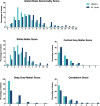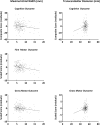Preterm brain injury on term-equivalent age MRI in relation to perinatal factors and neurodevelopmental outcome at two years
- PMID: 28486543
- PMCID: PMC5423624
- DOI: 10.1371/journal.pone.0177128
Preterm brain injury on term-equivalent age MRI in relation to perinatal factors and neurodevelopmental outcome at two years
Abstract
Objectives: First, to apply a recently extended scoring system for preterm brain injury at term-equivalent age (TEA-)MRI in a regional extremely preterm cohort; second, to identify independent perinatal factors associated with this score; and third, to assess the prognostic value of this TEA-MRI score with respect to early neurodevelopmental outcome.
Study design: 239 extremely preterm infants (median gestational age [range] in weeks: 26.6 [24.3-27.9]), admitted to the Wilhelmina Children's Hospital between 2006 and 2012 were included. Brain abnormalities in white matter, cortical and deep grey matter and cerebellum and brain growth were scored on T1- and T2-weighted TEA-MRI using the Kidokoro scoring system. Neurodevelopmental outcome was assessed at two years corrected age using the Bayley Scales of Infant and Toddler Development, third edition. The association between TEA-MRI and perinatal factors as well as neurodevelopmental outcome was evaluated using multivariable regression analysis.
Results: The distribution of brain abnormalities and brain metrics in the Utrecht cohort differed from the original St. Louis cohort (p < .05). Mechanical ventilation >7 days (β [95% confidence interval, CI]: 1.3 [.5; 2.0]) and parenteral nutrition >21 days (2.2 [1.2; 3.2]) were independently associated with higher global brain abnormality scores (p < .001). Global brain abnormality scores were inversely associated with cognitive (β in composite scores [95% CI]: -.7 [-1.2; -.2], p = .004), fine motor (β in scaled scores [95% CI]: -.1 [-.3; -.0], p = .007) and gross motor outcome (β in scaled scores [95% CI]: -.2 [-.3; -.1], p < .001) at two years corrected age, although the explained variances were low (R2 ≤.219).
Conclusion: Patterns of brain injury differed between cohorts. Prolonged mechanical ventilation and parenteral nutrition were identified as independent perinatal risk factors. The prognostic value of the TEA-MRI score was rather limited in this well-performing cohort.
Conflict of interest statement
Figures


References
-
- Inder TE, Wells SJ, Mogridge NB, Spencer C, Volpe JJ. Defining the nature of the cerebral abnormalities in the premature infant: a qualitative magnetic resonance imaging study. J Pediatr 2003;143:171–9. doi: 10.1067/S0022-3476(03)00357-3 - DOI - PubMed
-
- Miller SP, Ferriero DM, Leonard C, Piecuch R, Glidden DV, Partridge JC, et al. Early brain injury in premature newborns detected with magnetic resonance imaging is associated with adverse early neurodevelopmental outcome. J Pediatr 2005;147:609–16. doi: 10.1016/j.jpeds.2005.06.033 - DOI - PubMed
-
- Childs AM, Cornette L, Ramenghi LA, Tanner SF, Arthur RJ, Martinez D, et al. Magnetic resonance and cranial ultrasound characteristics of periventricular white matter abnormalities in newborn infants. Clin Radiol 2001;56:647–55. doi: 10.1053/crad.2001.0754 - DOI - PubMed
-
- Kidokoro H, Neil JJ, Inder TE. New MR imaging assessment tool to define brain abnormalities in very preterm infants at term. AJNR Am J Neuroradiol 2013;34:2208–14. doi: 10.3174/ajnr.A3521 - DOI - PMC - PubMed
-
- Boardman JP, Craven C, Valappil S, Counsell SJ, Dyet LE, Rueckert D, et al. A common neonatal image phenotype predicts adverse neurodevelopmental outcome in children born preterm. Neuroimage 2010;52:409–14. doi: 10.1016/j.neuroimage.2010.04.261 - DOI - PubMed
MeSH terms
LinkOut - more resources
Full Text Sources
Other Literature Sources
Medical

